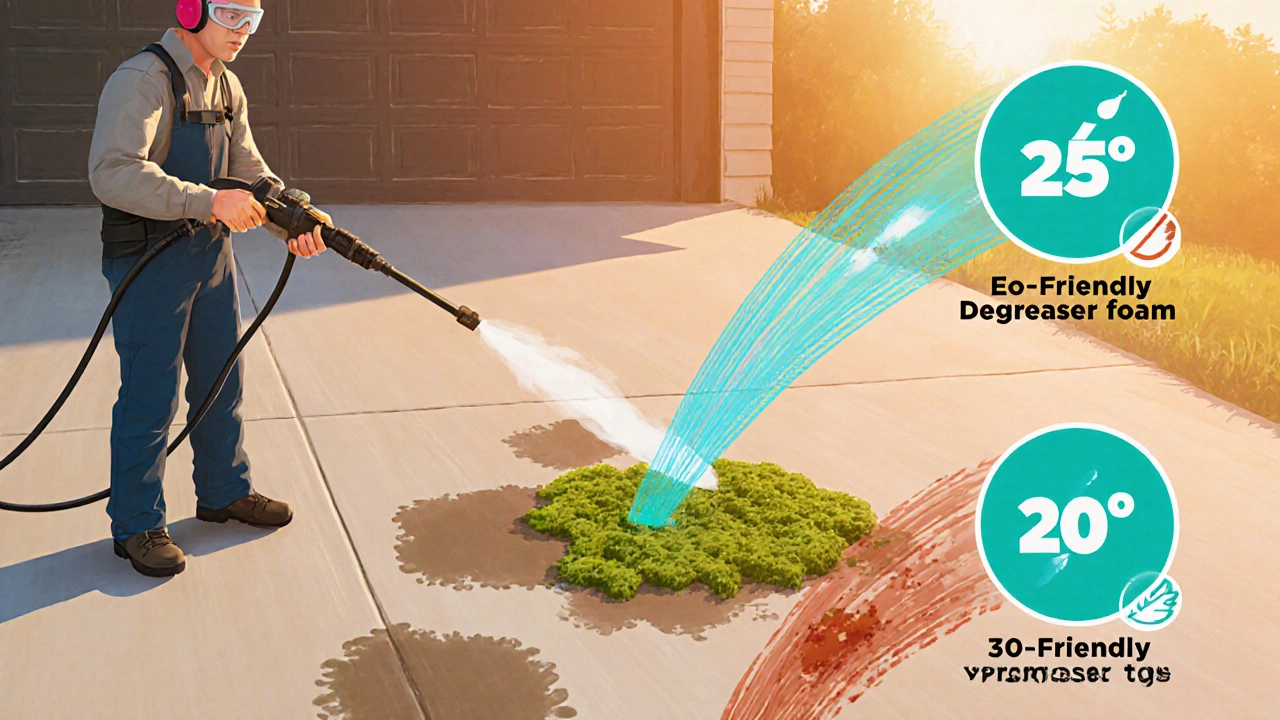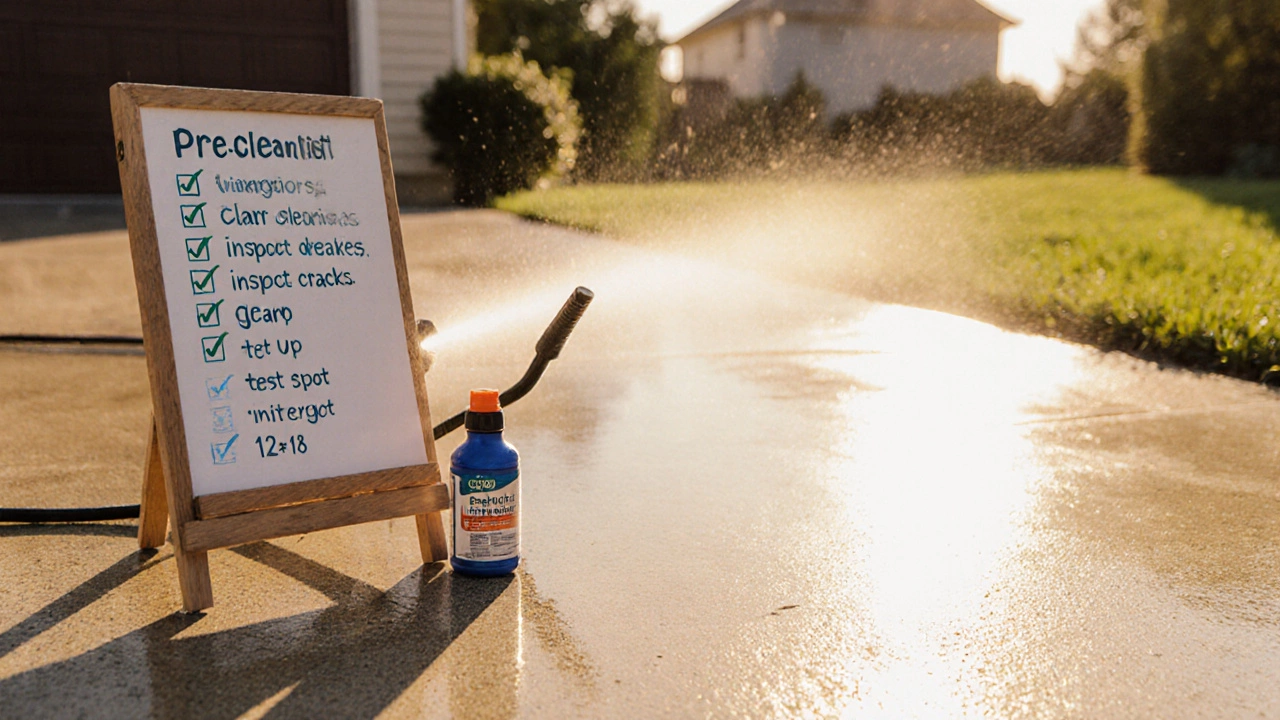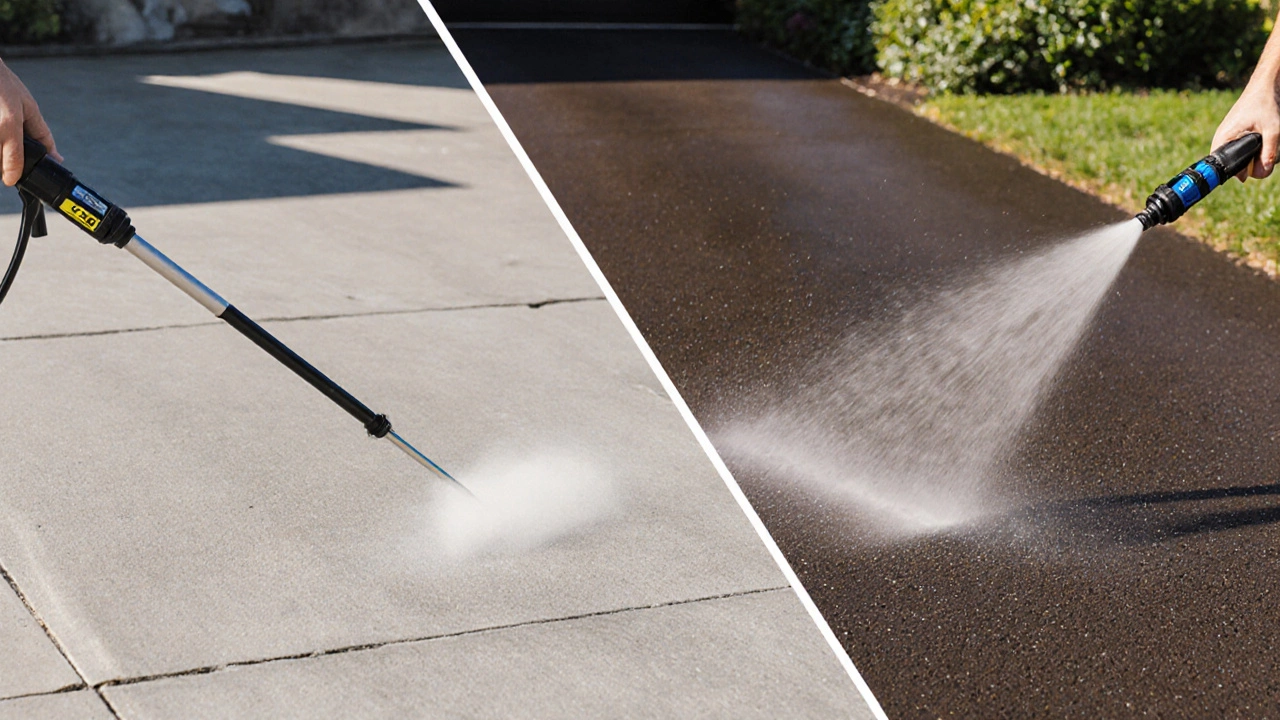Driveway Pressure Washer PSI Calculator
Driveway Pressure Washer Settings Calculator
Recommended Settings
Calculate to see resultsEnter your driveway details above to get recommended pressure washer settings.
Important Safety Tips
Select your driveway type to see safety recommendations.
Wondering how much PSI you need for a driveway? Getting the right pressure is key to a clean surface without gouging the concrete.
Driveway pressure washing is a cleaning method that uses high‑pressure water jets to strip away oil, moss, rust and everyday grime from driveway surfaces. When you match the machine’s power to the material, you get results fast and avoid costly repairs.Key Takeaways
- Concrete driveways usually need 3000-3500PSI, while asphalt tolerates 2500-3000PSI.
- GPM (gallons per minute) works with PSI - aim for 2.5-3.0GPM for most residential jobs.
- Keep the nozzle 12-18 inches away for gentle cleaning; move closer only for stubborn stains.
- Use an eco‑friendly detergent for oil and grease; it protects the environment and the surface.
- Follow the pre‑check checklist to prevent surface damage before you fire up the washer.
Understanding PSI and GPM
Two numbers define a pressure washer’s cleaning power: PSI (pounds per square inch) and GPM (gallons per minute). PSI tells you how hard the water hits the surface; GPM tells you how much water flows, which influences how quickly soil is lifted.
Think of PSI as the strength of a punch and GPM as the speed of the punch. A high‑PSI, low‑GPM unit can cut deep but may leave streaks, while a high‑GPM, moderate‑PSI machine cleans faster with less risk of gouging.
Matching PSI to Driveway Material
Concrete driveway is the most common surface in the UK. Its dense, porous nature tolerates higher pressures, making 3000-3500PSI the sweet spot. Anything above 4000PSI can chip the surface, especially if you use a narrow‑tip nozzle.
Asphalt driveway is softer and more prone to stripping. Stick to 2500-3000PSI and use a 25‑degree nozzle to spread the force evenly.
If you have a decorative stamped or dyed concrete surface, start at the lower end (2500PSI) and test a hidden area.

Choosing the Right Pressure Washer
Not every pressure washer is built for driveways. Here’s what to look for:
- Pump type: Gas‑driven pumps deliver higher PSI (up to 4500) but are noisy and emit fumes. Electric models cap at ~3500PSI and are ideal for residential use.
- PSI range: Pick a unit that lets you dial between 2000 and 4000PSI - flexibility matters when you switch between concrete and asphalt.
- GPM rating: 2.5-3.0GPM offers a good balance of speed and cleaning power.
- Nozzle options: A 25‑degree tip for general cleaning, 15‑degree for oily stains, and a 40‑degree tip for delicate surfaces.
For most homeowners, a 3000PSI, 2.8GPM electric washer with interchangeable nozzles hits the sweet spot.
Adjusting PSI for Common Stains
Different stains demand different approaches. Here’s a quick cheat sheet:
- Oil and grease: Start at 2500PSI with a 15‑degree nozzle, apply an eco‑friendly degreaser, let it dwell for 5‑10 minutes, then increase to 3000PSI if needed.
- Moss or algae: A 30‑degree nozzle at 2800PSI combined with a mild bleach‑free cleaner works well.
- Rust or iron deposits: Use a 20‑degree tip, 3000PSI, and a rust‑removing detergent. Keep the spray moving to avoid etching.
Never stay in one spot for longer than 2 seconds; even the toughest stain can turn into a permanent scar.
Best Practices to Avoid Surface Damage
Even the right PSI can hurt a driveway if you misuse the equipment. Follow these rules:
- Distance: Hold the wand 12‑18 inches from concrete, 18‑24 inches from asphalt.
- Angle: Keep the spray at a 45‑degree angle to the surface; a perpendicular blast concentrates force.
- Movement: Sweep in overlapping passes, never pause.
- Nozzle wear: Check for cracks; a damaged nozzle can create spikes that gouge.
- Pre‑rinse: Remove loose debris with a garden hose before pressurizing - this prevents grit from grinding the surface.
Eco‑Friendly Cleaning Options
Many homeowners worry about chemicals runoff. Eco‑friendly detergent blends (often plant‑based surfactants) break down oil without harming the surrounding soil.
Look for products certified by the European Eco‑Label or the UK’s Green Seal. They typically contain < 5% phosphates and biodegrade within 48 hours.
Mix according to the label - usually 1-2oz per 10gal of water - and apply with a low‑pressure detergent wand before switching to full pressure.

PSI Comparison Table for Common Surfaces
| Material | Typical PSI | Nozzle Angle | Recommended Distance |
|---|---|---|---|
| Concrete (plain) | 3000-3500PSI | 25° | 12-18 in |
| Concrete (stamped/dyed) | 2500-3000PSI | 30° | 14-20 in |
| Asphalt | 2500-3000PSI | 25° | 18-24 in |
| Brick pavers | 2000-2500PSI | 40° | 18-24 in |
| Wood deck (treated) | 1500-2000PSI | 40° | 20-30 in |
Pre‑Cleaning Checklist
- Clear the driveway of vehicles, plant pots, and loose debris.
- Inspect the surface for cracks; seal any large gaps before washing.
- Gather protective gear: safety glasses, non‑slip boots, hearing protection.
- Test the pressure on a small, hidden spot.
- Prepare eco‑friendly detergent according to label instructions.
Common Mistakes and How to Fix Them
Too much pressure: You’ll see chalky white spots on concrete. Reduce PSI by 500 and increase the nozzle angle.
Holding the wand too close: Creates deep gouges. Pull back to the recommended distance and keep the wand moving.
Skipping detergent: Stubborn oil will lurk under the surface. Apply a biodegradable degreaser and let it sit.
Frequently Asked Questions
What PSI is safe for a new concrete driveway?
For a freshly poured concrete slab, stay at 2500PSI or lower for the first few weeks. This prevents surface weakening while the concrete continues to cure.
Can I use a pressure washer on an oil‑stained driveway without detergent?
You can remove light oil with high pressure alone, but for deeper stains an eco‑friendly degreaser dramatically improves results and reduces the need for extra passes.
Is a 3500PSI electric washer enough for a large driveway?
Yes, as long as the unit delivers 2.5-3.0GPM. The combination of steady flow and moderate pressure cleans efficiently without the bulk of a gas‑powered machine.
How often should I pressure wash my driveway?
A spring clean after winter and an annual refresh in late summer keep grit, oil, and algae at bay. If you notice oil spots after car maintenance, spot‑clean immediately.
Do I need a special nozzle for asphalt?
A 25‑degree nozzle works well for most asphalt. If the surface is older or has a loose top layer, switch to a 30‑degree tip to spread the force.
